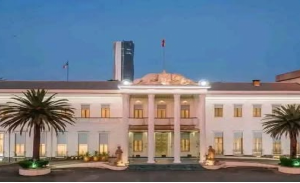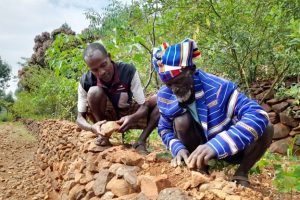
COMPILED BY TEWODROS KASSA
Historians indicate that Lalibela embraced the wonders architecture on the earth. The church attracts millions of tourists following its mystery that showcases unbelievable art of construction.
Lalibela’s rock-hewn churches are situated in the north of the country in the city named after their constructor, King Lalibela, a former Zagwe Dynasty Emperor of Ethiopia. In a mountainous region in the heart of Ethiopia, some 645 km from Addis Ababa, eleven medieval monolithic churches were carved out of rock. Their building is attributed to King Lalibela who set out to construct in the 12th century a ‘New Jerusalem’. Lalibela flourished after the decline of the Aksum Empire. Lalibela is found in the North Wollo Zone of the Amhara state, which sits at approximate 2400m above sea level. It is a rocky and mountainous area that is dry and often prone to droughts and was once the location of the historic capital of Ethiopia.
According to the United Nations Educational, Scientific and Cultural Organization (UNESCO), unsurprisingly this site has had a large influence on Christianity in Ethiopia and indeed the entire region. The population in this region of the country overwhelmingly identify as Ethiopian Orthodox Christian. For this reason, the site retains its holy status and still remains highly popular with pilgrims in Africa and the world over.
The churches take inspiration from many Christian symbols such as the 12 apostles, the many saints of the faith and the Virgin Mary. Inside Lalibela’s churches, recreations of famous religious artifacts such as the tomb of Adam and the tomb of Jesus can be found. The historic rock-carved churches have at times in history even substituted for holy sites like Jerusalem and Bethlehem for pilgrims, when travel to the holy land was restricted.
There are two main groups of churches – to the north of the river Jordan: Biete Medhani Alem (House of the Saviour of the World), Biete Mariam (House of Mary), Biete Maskal (House of the Cross), Biete Denagel (House of Virgins), Biete Golgotha Mikael (House of Golgotha Mikael); and to the south of the river, Biete Amanuel (House of Emmanuel), Biete Qeddus Mercoreus (House of St. Mercoreos), Biete Abba Libanos (House of Abbot Libanos), Biete Gabriel Raphael (House of Gabriel Raphael), and Biete Lehem (House of Holy Bread). The eleventh church, Biete Ghiorgis (House of St. George), is isolated from the others, but connected by a system of trenches.
The churches were not constructed in a traditional way but rather were hewn from the living rock of monolithic blocks. These blocks were further chiseled out, forming doors, windows, columns, various floors, roofs etc. This gigantic work was further completed with an extensive system of drainage ditches, trenches and ceremonial passages, some with openings to hermit caves and catacombs.
Biete Medhani Alem, with its five aisles, is believed to be the largest monolithic church in the world, while Biete Ghiorgis has a remarkable cruciform plan. Most were probably used as churches from the outset, but Biete Mercoreos and Biete Gabriel Rafael may formerly have been royal residences. Several of the interiors are decorated with mural paintings.
Near the churches, the village of Lalibela has two storey round houses, constructed of local red stone, and known as the Lasta Tukuls. These exceptional churches have been the focus of pilgrimage for Coptic Christians since the 12th century.
According to geologists, the geology of the region partially determined the structure of the churches and their hydraulic systems. Igneous in nature, the rocky massif of the church complex is primarily composed of two kinds of volcanic basalt. The churches have been carved top-down from the sections of porous basaltic scoriae using chisels, axes, and other blades. Workers first traced the perimeter of the structure on the rock face; then isolated the main structure of the church. Finally, the inner mass was sculpted as the exterior was refined and ornamented. Unlike in built construction, where the last element constructed is at the top, this method of construction leaves the most recently hewn element at the bottom. To avoid flooding from underground rivers and water tables, the church builders excavated drainage canals and trenches. The roofs of the four freestanding monolithic churches slope at the same angle of the rocks from which they were carved, further promoting drainage. Additional hydraulic systems filled cisterns and baptismal pools, including the three pools in the courtyard of Biete Mariam.
The churches of Lalibela are square or rectangular in form, with basilical or cruciform plans. Except where geological formations forced alterations, the churches follow the Orthodox custom of placing a door at each of the western, northern, and southern sides. Steps and steep pedestals lead visitors upward into the churches, lifting them from the carved trenches and pathways.
In sum, centuries after its construction, Lalibela remains home to a large community of Ethiopian Orthodox priests and nuns. Since the twelfth century, the city has been a continued site of religious practice and popular pilgrimage. Gatherings of pilgrims are especially large on major feast days and on Orthodox Christmas (Genna), held on January 7 in the Gregorian calendar.
THE ETHIOPIAN HERALD FRIDAY 8 JULY 2022





